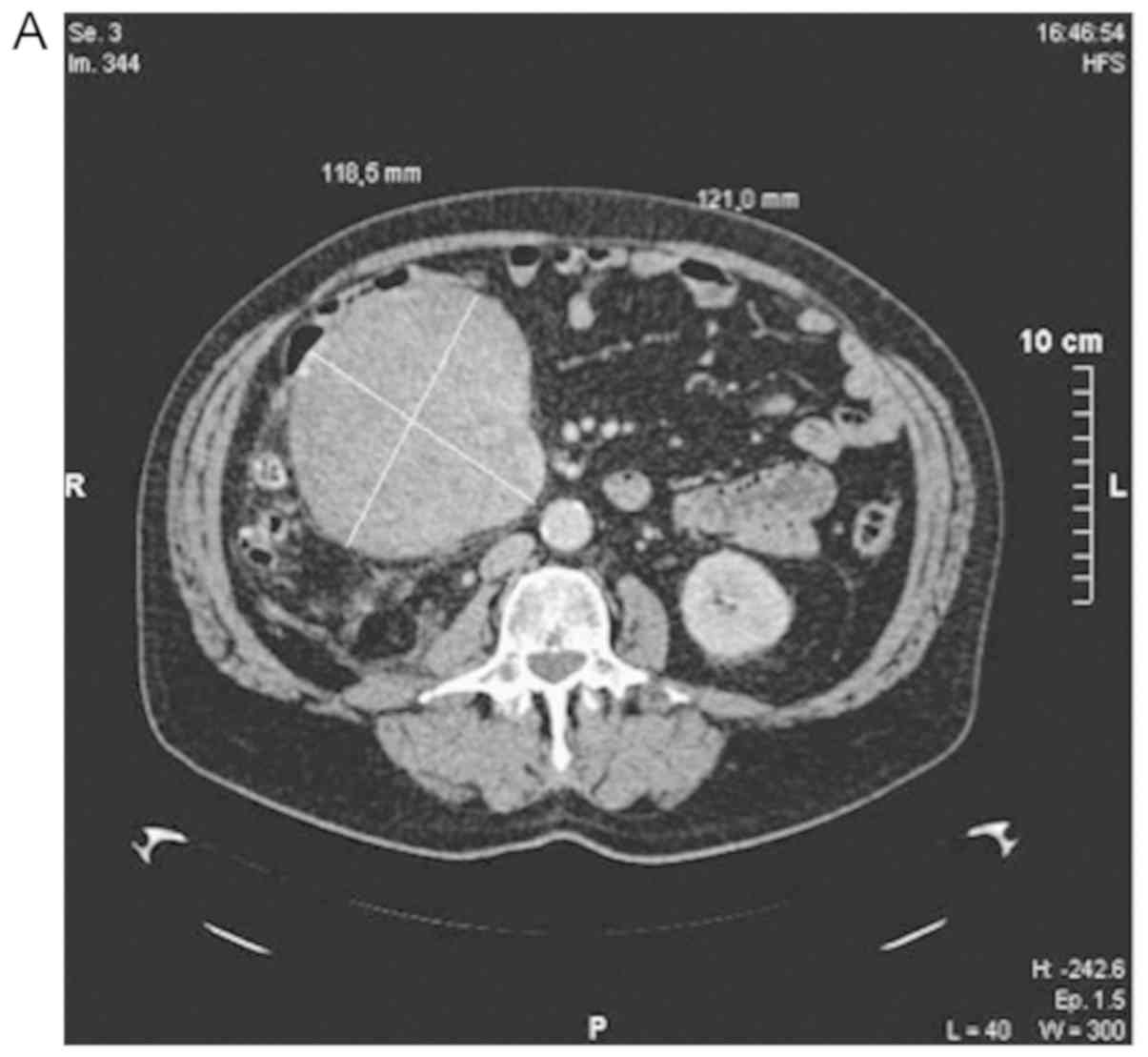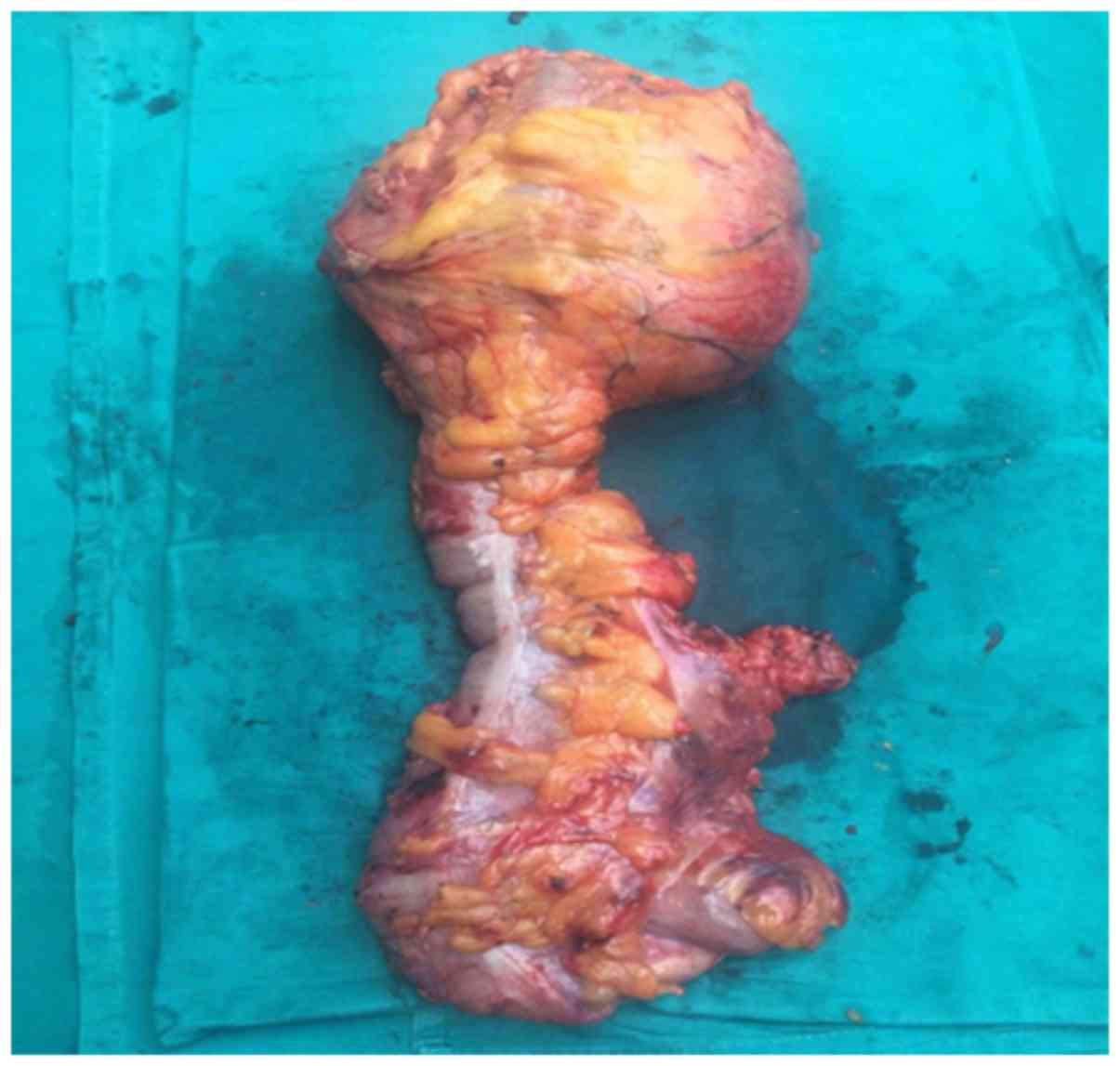Robotic resection of a giant retroperitoneal leiomyosarcoma: A case report
- Authors:
- Published online on: October 3, 2019 https://doi.org/10.3892/mco.2019.1928
- Pages: 599-601
Abstract
Introduction
The utilization of robotic systems in surgery has emerged as an alternative to open and laparoscopic surgery with the preliminary results being promising to date (1). Initially used in urologic operations (2) and cholecystectomies (3), the application of the Da Vinci platform has lately expanded to more challenging cases such as aneurysm repair (4) and liver (5) and pancreatic resections (6). The advantages of this technology include better visibility via three-dimensional (3D) imaging, stable field, enhanced maneuverability due to articulated instruments and greater precision in the dissection of tissues (7).
Retroperitoneal sarcomas (RPS) are malignant neoplasms that account for 10–15% of all soft-tissue tumors (8). Histological tumor type, grade, location and extension of resection have been well-documented prognostic factors for long-term survival. Given the complex nature of RPS surgery, much emphasis has recently been placed on the appropriate referral and management of these patients at specialized centers in order to ensure high quality of surgical care (9).
Herein, we present the first described case of robotic resection of a retroperitoneal leiomyosarcoma (RPLM) in a high-volume center for robotic operations.
Case report
A 72-year-old male was admitted due to progressive abdominal distension, dull abdominal pain for the last 3 months, constitutional symptoms and constipation. Physical examination revealed a slightly distended abdomen and an abdominal mass in right side which appeared hard and immobile.
The patient subsequently underwent an abdominal and pelvic computed tomography (CT) (Fig. 1A) and magnetic resonance imaging (MRI) (Fig. 1B) which revealed a solid heterogeneous lesion 12,1×11,8×15 cm located from the descending part of the duodenum and head of the pancreas to transverse mesocolon and a second smaller lesion 3×2,7 cm infiltrating the ascending colon. No major vessels were invaded and no liver metastases were reported.
The patient was scheduled for elective robotic tumor excision after acknowledging the risks of this challenging operation and the benefits derived from utilizing the robotic system in this particular occasion.
Intraoperatively, a gigantic retroperitoneal mass was revealed compressing the duodenum and the pancreatic groove, yet did not invade it. The second smaller mass was infiltrating the ascending colon. The mass was dissected from the duodenum, head of the pancreas and the right kidney using sharp and blunt dissection without any breach of tumor capsule. After dissection, the tumor was extracted completely. An upper midline incision was performed and a right hemicolectomy was performed (Fig. 2). A frozen section was sent from the margin of remaining tissue, which was negative for malignancy. Meticulous hemostasis was performed to ensure no residual bleeding. The operative time was 7.5 h including the robotic docking time of 30 min. There were no intraoperative or postoperative complications and the patient was discharged home on the 4th postoperative day.
The histopathology report described a 19×17,5 cm retroperitoneal pleomorphic leiomyosarcoma, grade 3, mitotic index of 10 mitoses per 50 high power fields, CD 117 [C-KIT (−)], CD 68, Ki67 (MIBI)(+). The surgical margins were free of disease. Postoperatively the patient was evaluated by medical oncology and radiation oncology.
Discussion
Patients with RPS are usually diagnosed late, when the tumor is already of considerable size and close or attached to critical retroperitoneal structures and organs. This physical history limits the ability of surgeons to perform wide resections with clear margins. Importantly, incomplete surgical resection comprises one of the greatest risk factors locoregional recurrence and poor survival (10).
The management of bulky intra-abdominal extra-luminal tumors is challenging due to their close proximity or diffusion of other structures. The surgical resection of RPLM can be associated with significant morbidity given that they usually invade important vascular structures such as the inferior vena cava (IVC) and tributaries, the duodenum and the ureter (11). The intraoperative 30-day mortality rate has been reported to be as high as 15% in resections of RPLMs arising from the IVC (12). However, a curative intent operation entails a wide resection incorporating the tumor and all the involved structures (e.g duodenum, colon, kidney, IVC) in order to achieve adequate resection margins (13).
Robotic surgery is a minimally invasive approach that has gained significant popularity over the last decade. Advantages of this procedure include less intraoperative blood loss, better visualization, shorter hospital stay, and rapid patient recovery (14). Importantly, thanks to the highly articulated instruments and the increased precision in surgical manipulation, the robotic system is even more important in cases requiring fine dissection, such as cases invading the IVC or the aorta (5). Although in our case the patient recovered rapidly, uneventfully, after a resection with clear margins, there is a paucity of data on the oncologic outcomes of such operations in large series; yet preliminary results in several cancer centers are promising (15).
In this report, we describe the utilization of the robotic Da Vinci platform by our experienced team made the resection of the giant tumor feasible without limiting the oncologic outcome of the operation. The three-dimensional imaging system was beneficial in understanding the relationship of the mass to the ureter, aorta and vena cava as well as colon and small bowel. Further reports are needed to elucidate the cases that can take advantage of the robotic technology.
Acknowledgements
Not applicable.
Funding
No funding was received.
Availability of data and materials
The datasets used and/or analyzed during the present study are available from the corresponding author on reasonable request.
Authors' contributions
MCM, PGA, MK, PC, FA, AM, DIT, KMK and AI conceived and designed the present work. MKK, KMK and DM performed the data analysis. MCM and KMK drafted the manuscript. MCM, PGA, MK, PC, FA, AM, DIT, AI, MKK, DM and KMK critically revised the manuscript, provided approval of the final version and agreed to be accountable for all aspects of the work.
Ethics approval and consent to participate
The study was conducted according to the Declaration of Helsinki.
Patient consent for publication
Written informed consent was obtained from the patient for publication of this Case Report/any accompanying images.
Competing interests
The authors declare that they have no competing interests.
References
|
Hazey JW and Melvin WS: Robot-assisted general surgery. Semin Laparosc Surg. 11:107–112. 2004.PubMed/NCBI | |
|
Vince R, Hampton LJ, Vartolomei MD, Shariat SF, Porpiglia F and Autorino R: Robotic assisted simple prostatectomy: Recent advances. Curr Opin Urol. 28:309–314. 2018. View Article : Google Scholar : PubMed/NCBI | |
|
Angelou A, Skarmoutsos A, Margonis GA, Moris D, Tsigris C and Pikoulis E: Robotic single port cholecystectomy: Current data and future perspectives. Minerva Chir. 72:140–145. 2017.PubMed/NCBI | |
|
Makris MC, Moris D, Papalouca K, Malietzis G and Makris GC: The current status of robotic vascular surgery in the abdominal cavity. Int Angiol. 35:1–7. 2016.PubMed/NCBI | |
|
Tsilimigras DI, Moris D, Vagios S, Merath K and Pawlik TM: Safety and oncologic outcomes of robotic liver resections: A systematic review. J Surg Oncol. 117:1517–1530. 2018. View Article : Google Scholar : PubMed/NCBI | |
|
Kornaropoulos M, Moris D, Beal EW, Makris MC, Mitrousias A, Petrou A, Felekouras E, Michalinos A, Vailas M, Schizas D and Papalampros A: Total robotic pancreaticoduodenectomy: A systematic review of the literature. Surg Endosc. 31:4382–4392. 2017. View Article : Google Scholar : PubMed/NCBI | |
|
Konstantinidis KM, Hiridis S and Karakitsos D: Robotic-assisted surgical removal of pelvic schwannoma: A novel approach to a rare variant. Int J Med Robot. 7:55–59. 2011. View Article : Google Scholar : PubMed/NCBI | |
|
von Mehren M, Randall RL, Benjamin RS, Boles S, Bui MM, Conrad EU III, Ganjoo KN, George S, Gonzalez RJ, Heslin MJ, et al: Soft tissue sarcoma, version 2.2016, NCCN clinical practice guidelines in oncology. J Natl Compr Canc Netw. 14:758–786. 2016. View Article : Google Scholar : PubMed/NCBI | |
|
Moris D, Petrou A, Papalampros A, Tsilimigras DI and Felekouras E: Retroperitoneal sarcomas: Does the center really matter? Surgery. 163:971–972. 2018. View Article : Google Scholar : PubMed/NCBI | |
|
Stahl JM, Corso CD, Park HS, An Y, Rutter CE, Han D and Roberts KB: The effect of microscopic margin status on survival in adult retroperitoneal soft tissue sarcomas. Eur J Surg Oncol. 43:168–174. 2017. View Article : Google Scholar : PubMed/NCBI | |
|
Petrou A, Constantinidou A, Kontos M, Papalampros A, Moris D, Bakoyiannis C, Neofytou K, Kourounis G and Felekouras E: Comprehensive surgical treatment as the mainstay of management in retroperitoneal sarcomas: Retrospective study from two non-sarcoma specialist centers. Anticancer Res. 37:2025–2031. 2017. View Article : Google Scholar : PubMed/NCBI | |
|
Konofaos P, Spartalis E, Moris D, Athanasiou A, Dimitroulis D, Markakis C, Kostakis ID, Nikiteas N and Kouraklis G: Challenges in the surgical treatment of retroperitoneal sarcomas. Indian J Surg. 78:1–5. 2016. View Article : Google Scholar : PubMed/NCBI | |
|
Trans-Atlantic RPS Working Group, . Management of recurrent retroperitoneal sarcoma (RPS) in the adult: A consensus approach from the trans-atlantic RPS working group. Ann Surg Oncol. 23:3531–3540. 2016. View Article : Google Scholar : PubMed/NCBI | |
|
Jayne D, Pigazzi A, Marshall H, Croft J, Corrigan N, Copeland J, Quirke P, West N, Rautio T, Thomassen N, et al: Effect of robotic-assisted vs. conventional laparoscopic surgery on risk of conversion to open laparotomy among patients undergoing resection for rectal cancer: The rolarr randomized clinical trial. JAMA. 318:1569–1580. 2017. View Article : Google Scholar : PubMed/NCBI | |
|
Holmer C and Kreis ME: Systematic review of robotic low anterior resection for rectal cancer. Surg Endosc. 32:569–581. 2018. View Article : Google Scholar : PubMed/NCBI |











